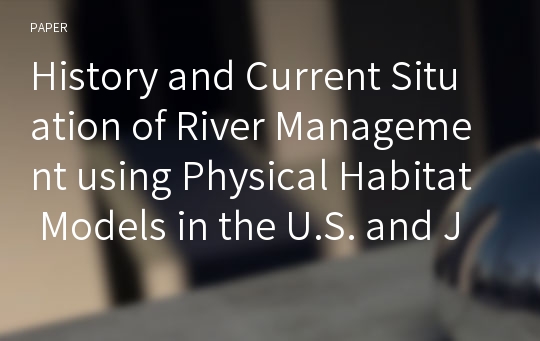History and Current Situation of River Management using Physical Habitat Models in the U.S. and Japan
* 본 문서는 배포용으로 복사 및 편집이 불가합니다.
서지정보
ㆍ발행기관 : 한국하천호수학회
ㆍ수록지정보 : 생태와 환경 / 46권 / 1호
ㆍ저자명 : Masahiko Sekine
ㆍ저자명 : Masahiko Sekine
영어 초록
History of Instream Flow Incremental Methodology (IFIM) Following the large reservoir and water development era of the mid-twentieth century in North America, resource agencies became concerned over the loss of many miles of riverine fish and wildlife resources in the arid western United States. Consequently, several western states began issuing rules for protecting existing stream resources from future depletions caused by accelerated water development. Many assessment methods appeared during the 1960’s and early 1970’s. These techniques were based on hydrologic analysis of the water supply and hydraulic considerations of critical stream channel segments, coupled with empirical observations of habitat quality and an understanding of riverine fish ecology. Following enactment of the National Environmental Policy Act (NEPA) of 1970, attention was shifted from minimum flows to the evaluation of alternative designs and operations of federally funded water projects. Methods capable of quantifying the effect of incremental changes in stream flow to evaluate a series of possible alternative development schemes were needed. This need led to the development of habitat versus discharge functions developed from life stage-specific relations for selected species, that is, fish passage, spawning, and rearing habitat versus flow for trout or salmon. During the late 1970’s and early 1980’s, an era of small hydropower development began. Hundreds of proposed hydropower sites in the Pacific Northwest and New England regions of the United States came under intensive examination by state and federal fishery management interests. During this transition period from evaluating large federal reservoirs to evaluating license applications for small hydropower, the Instream Flow Incremental Methodology (IFIM) was developed under the guidance of the U.S. Fish and Wildlife Service (USFWS).참고 자료
없음"생태와 환경"의 다른 논문
 북한강 수계에서 이취미를 유발하는 남조류(Anabaena spiroides)의 증식 특성10페이지
북한강 수계에서 이취미를 유발하는 남조류(Anabaena spiroides)의 증식 특성10페이지 도암호에서 하절기 수질의 장기적인 경향7페이지
도암호에서 하절기 수질의 장기적인 경향7페이지 부유습지를 이용한 부영양수계 현장 수질개선 효과12페이지
부유습지를 이용한 부영양수계 현장 수질개선 효과12페이지 영산강 수계의 본류 및 지천에서 4대강 사업 전∙후의 어류분포 및 군집구조 특성 비교13페이지
영산강 수계의 본류 및 지천에서 4대강 사업 전∙후의 어류분포 및 군집구조 특성 비교13페이지 섬진강상류 유량측정지점의 유수단면적과 유량변화에 따른 상관관계 분석9페이지
섬진강상류 유량측정지점의 유수단면적과 유량변화에 따른 상관관계 분석9페이지 수생식물이 발달된 습지에서 동물플랑크톤 군집 분포: 수생식물의 밀도 및 종류가 부착성 윤충류와 지각..8페이지
수생식물이 발달된 습지에서 동물플랑크톤 군집 분포: 수생식물의 밀도 및 종류가 부착성 윤충류와 지각..8페이지 환경 조건 차이에 의한 경안천 토양의 유기물 분해속도와 온실가스 발생 변화11페이지
환경 조건 차이에 의한 경안천 토양의 유기물 분해속도와 온실가스 발생 변화11페이지 독도 곤충상 조사에 따른 최근 종 조성도 변화 보고7페이지
독도 곤충상 조사에 따른 최근 종 조성도 변화 보고7페이지 외래종 쌍별귀뚜라미(Gryllus bimaculatus)가 토착종 왕귀뚜라미 (Teleogryllu..8페이지
외래종 쌍별귀뚜라미(Gryllus bimaculatus)가 토착종 왕귀뚜라미 (Teleogryllu..8페이지 덕유산 국립공원 산림식생구조의 지형적 영향 분석7페이지
덕유산 국립공원 산림식생구조의 지형적 영향 분석7페이지

























